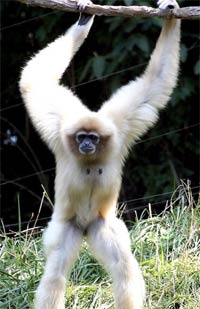|

 Master swingers: Also called the lesser apes, gibbons differ from great apes (chimpanzees, gorillas, orangutans and humans) in being smaller, pair-bonded, in not making nests, and in certain anatomical details in which they superficially more closely resemble monkeys than the great apes do. Gibbons are masters of their primary mode of locomotion, brachiation, swinging from branch to branch distances of up to 15 m (50 ft), at speeds as much as 56 km/h (35 mph). Their forearms are much longer than their hindlimbs. They can also make leaps of up to 8 m (27 ft), and walk bipedally with their arms raised for balance (which sometimes looks quite comical). Master swingers: Also called the lesser apes, gibbons differ from great apes (chimpanzees, gorillas, orangutans and humans) in being smaller, pair-bonded, in not making nests, and in certain anatomical details in which they superficially more closely resemble monkeys than the great apes do. Gibbons are masters of their primary mode of locomotion, brachiation, swinging from branch to branch distances of up to 15 m (50 ft), at speeds as much as 56 km/h (35 mph). Their forearms are much longer than their hindlimbs. They can also make leaps of up to 8 m (27 ft), and walk bipedally with their arms raised for balance (which sometimes looks quite comical).
Ball and socket: One unique aspect of gibbon physiology is that the wrist is composed of a ball and socket joint, allowing for biaxial movement. This greatly reduces the amount of energy needed in the upper arm and torso, while also reducing stress on the shoulder joint. They also have long hands and feet, with a deep cleft between the first and second digits of their hands. Their fur is usually black, gray, or brownish, often with white markings on hands, feet, and face. Some species have an enlarged throat sac, which inflates and serves as a resonating chamber when the animals call. This structure is enormous in a few species, equaling the size of the animal's head.
Who is who? Unlike most primates, gibbons do not show signs of being sexually dimorphic. They look the same in size, shape, and most physical aspects... in fact, sometimes the females are bigger than the males - an unusual trait in primates.

Mates for life: Gibbons are one of the few primates that live in male-female pairs (pair ponds), they mate in pairs, and they stay together for the span of their lives! The pair will then be joined by their children. Lone  gibbons are either old and have lost their mate, or young and attempting to find one and start their own family. gibbons are either old and have lost their mate, or young and attempting to find one and start their own family.
Haunting songs: Strongly territorial, gibbons defend their boundaries with vigorous visual and vocal displays. The vocal element, which can often be heard for long distances, consists of a duet between the mated pair, the young animals sometimes joining in. This eerie song can make them an easy find for poachers who engage in the illegal wildlife trade and in sales of body parts for use in traditional medicine. Most species are threatened or endangered, most importantly due to degradation or loss of their forest habitat.
Songs to keep an eye: Singing songs to each other helps the gibbon pairs to maintain a social bond, as well as to keep track of each other whenever they are separated.
Grooming in love: Grooming amongst the male-female pairs and the children in the family is an important social activity.
 Sleep all tucked in: Also unlike the other great apes, gibbons do not build nests. They can be seen sleeping curled into a semi-ball with their long arms wrapped around their knees and their head tucked into their lap. Sleep all tucked in: Also unlike the other great apes, gibbons do not build nests. They can be seen sleeping curled into a semi-ball with their long arms wrapped around their knees and their head tucked into their lap.
Diet: In the wild, gibbons can eat ripe fruit, leaves and a small amount of insects. Eating fruit occupies the brunt of their time feeding, next being time spend eating young leaves. Gibbons will spend nearly all their eating time up in the tree - rarely do they need to come down to the ground.
Possible Advertisement

Location: Gibbons are located in the wild primarily in Southeast Asia. They live in tropical and subtropical rainforests and small populations of them have been found in Laos, Vietnam, Cambodia, Thailand, China, Northeast India, Bangladesh Myanmar, Indonesia and Malayasia. They are considered engangered by most countries due to loss of their forest habitat, as well as some hunting and animal trafficking with the intention to use the animals for pets or parts. National parks and protected areas exist, but are often poorly supervised.

Bonobos | Chimpanzees | Gorillas |Human | Orangutans
Primates| Apes| Monkeys| Prosimians
All text is available under the terms
of the GNU Free Documentation License |